Heating element for a washing machine: characteristics, selection and repair tips
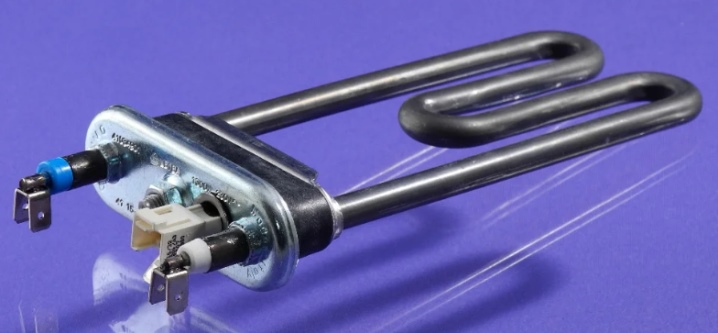
Any housewife will say that the washing machine is one of the most important things in the household. This makes sense, because this device allows you to significantly simplify the life of any housewife. An important element in a washing machine is an electric heating element, which is usually called a heating element. If it breaks down, then you simply cannot use the device. Let's try to figure out what kind of part it is, what it does, what are the signs of its breakdowns and how to fix them.
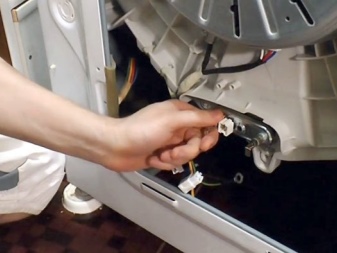
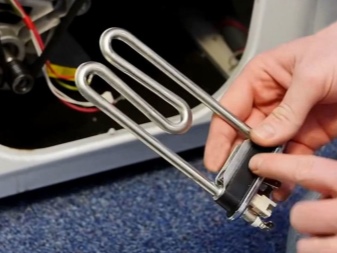
Device and principle of operation
The heating element is an electric heater that heats the water that comes from a hose connected to the centralized water supply to the washing machine. It is usually made of a V or W tube. It contains a highly resistive conductive element that can withstand very high operating temperatures. In addition, the heating coil is surrounded by a special insulator dielectric, which has excellent thermal conductivity. It serves to absorb heat that comes from the heating element and transfers it to the external part, which is made of steel.
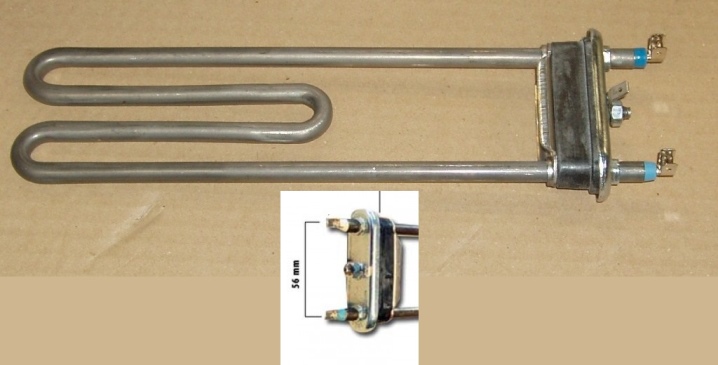
The working coil is usually soldered with its outgoing tips to the contacts, where voltage is applied during use. A thermo unit is usually located nearby, which measures the level of heating of the water in the tank. When a command is given through the control unit in any mode, the heating element receives a command to start work. It starts to get very hot, and due to the release of the heat that is generated, the water in the washing drum heats up to the desired temperature previously selected by the user.
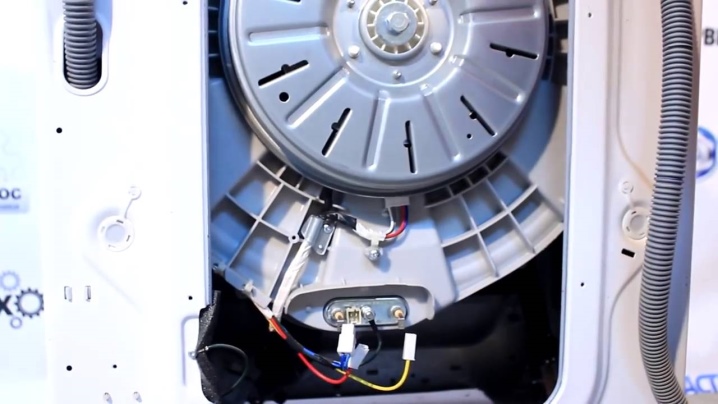
All this works together with a thermal sensor. This element monitors the level of water heating in the drum and turns off the working element at the right time, which makes it possible to use electricity as carefully as possible. When the water heats up to the right level, the sensor transmits this data to the control unit, after which its heating stops.
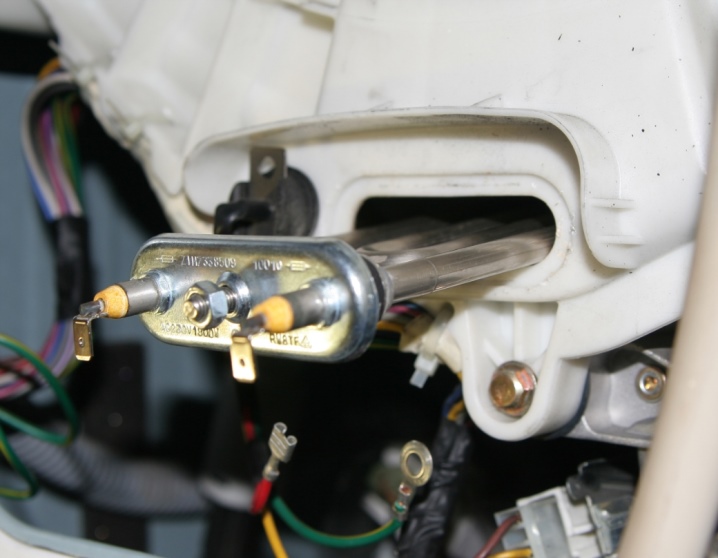
Where is?
The location of the heating element is extremely important, because the subtleties of parsing the machine and determining the malfunction depend on this... To find out where this element is located, you should look behind the back and check what dimensions the back cover has. If it is large, in the entire wall, then there is a high probability that the heating element is located right behind it, somewhere under the washing tub. Then it will be easy to get to the heating element - just unscrew the back wall.
If the cover is small, then most likely it is a hatch through which you can access the belt of the device. Then the heating element is located behind the front panel. It will be much more difficult to disassemble such a model.

The brand of the manufacturer of a specific model of the device can also help in this matter. For Electrolux, Ariston, Atlant, Whirlpool, Beko, Zanussi, Indesit and Candy devices, the heating element is usually located behind the back cover. But in the brand's models Hansa to extract the heating element requires remove the basement. For models of this brand with top loading, the heater is located on the side. And the washing machines of brands such as Samsung, Siemens, LG, Bosch, to replace the heater, you will need to dismantle the front panel.
It should also be added that before removing the part in question, it is necessary to drain the water from the machine, for which a container for collecting liquid and a rag should be prepared.
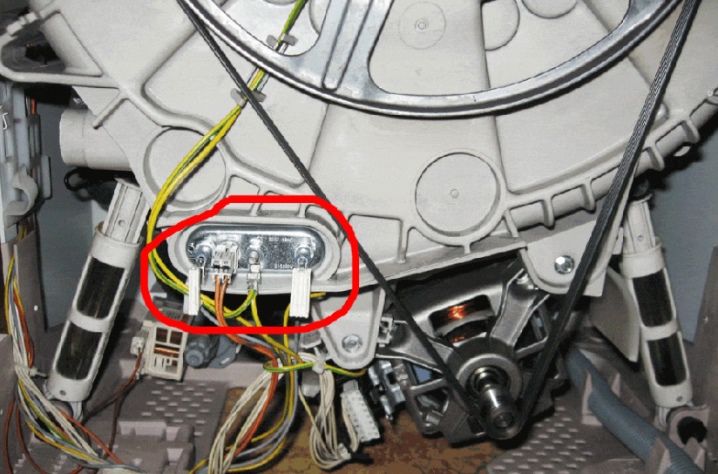
How to choose?
It is possible to choose a heating element for replacement in a typewriter based on a number of factors. Among them, the following should be highlighted:
- seat;
- the presence of a collar;
- hole for the sensor;
- length;
- heating element covering;
- the form;
- power;
- manufacturer.
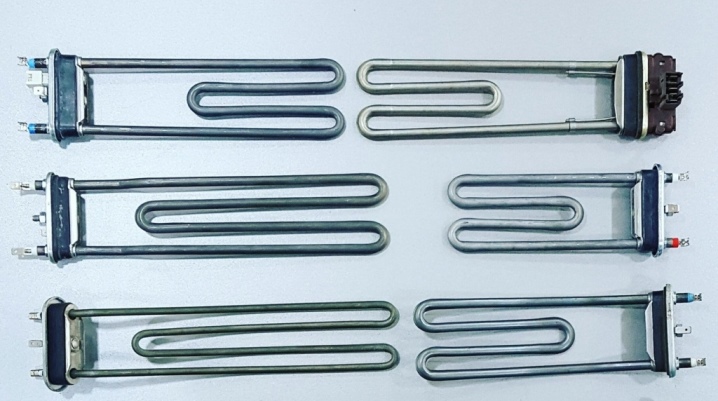
Now let's talk about each criterion in more detail. The most important thing when choosing a heating element is that the seat fits as much as possible. They have it almost the same. An exception will be items installed on older devices that are between 10 and 15 years old. If we talk about the presence of a shoulder, then this should also be taken into account. If you replace the heating element without it with an element with it, then it simply flies out of the tank during washing.

The next point - a number of models have a special hole for the sensor. On all such models, the sensor can be removed. Then the place of the sensor can be simply closed using a special plug.
An important physical parameter of the heating element will be the length.
According to this criterion, they are long, medium and short. The length will not be superfluous to take into account, but if the new part is longer or shorter than the old one, then this is not a problem. You can install a short analogue instead of a long one, but it may be impossible to do the opposite, due to the fact that the new part simply will not fit in its place.

Another characteristic would be power, although its significance is not so great. If the device is more powerful, then it will simply heat the water a little faster, and if it is less powerful, then a little longer. In general, there won't be much difference here.
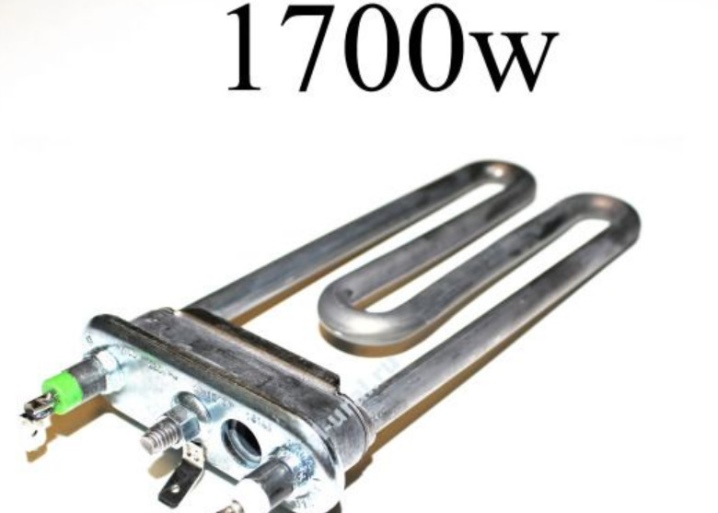
It is also important the shape of the device. As a rule, all heating elements are straight, but there are curved models. This should be taken into account so that the selected device fits into the washing machine and does not come into contact with other elements.
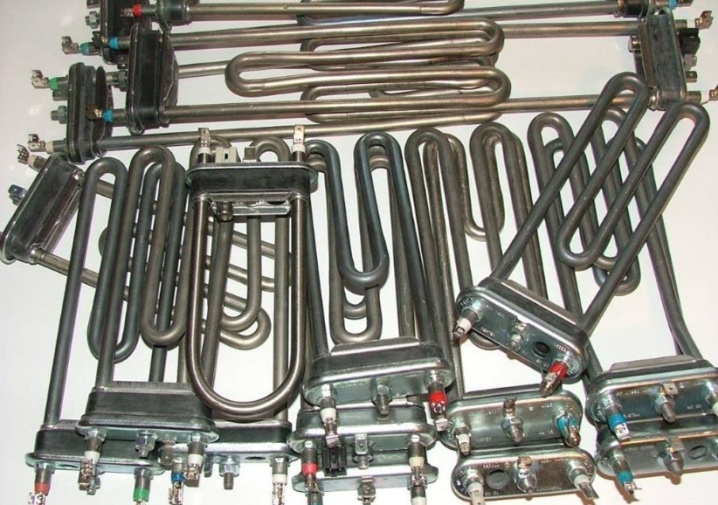
When selecting, it will not be superfluous to pay attention and to cover. There are devices with a ceramic or some other coating. But this is not of fundamental importance.
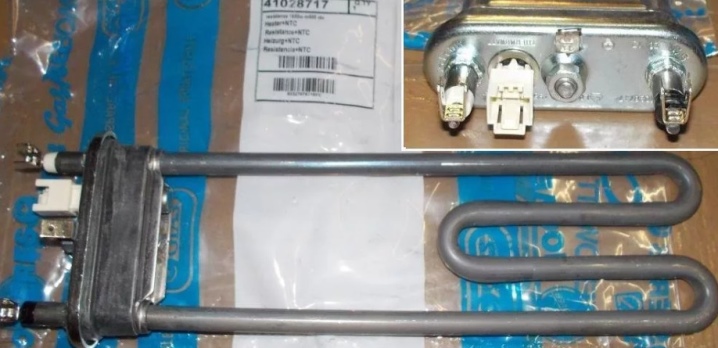
The last point to which it is recommended to pay attention - manufacturer of heating elements. If it is released by a brand Thermowatt, then this is the highest quality option. Slightly lower quality models are made by Irca. True, their advantage is the presence of a fuse. Another category of heating elements is made by a brand Blackmann. Their quality is not very good, but they are not very common.
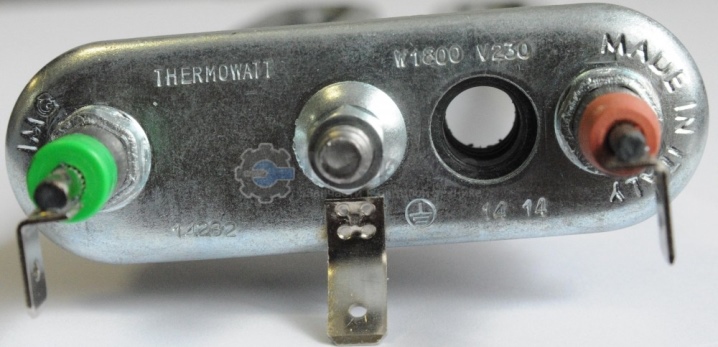
Causes of breakdowns
There are only 2 reasons for the malfunction of the heating element:
- manufacturing defects;
- scale.
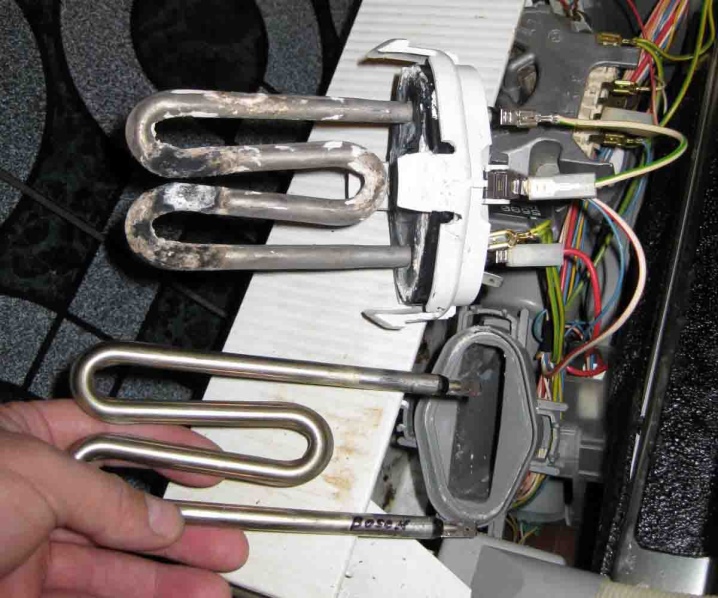
Now let's analyze each in a little more detail. Factory defect is not very common, but it still takes place. Its essence lies in the fact that with constant heating and cooling, the heating element spiral simply loses its properties and burns out. It can also happen that the dielectric burns out. But in this case, it will begin to pass current to the body of the washing machine. Here I must say that no one is insured against a factory defect, and it can even be in expensive models. That is, it is a matter of chance.
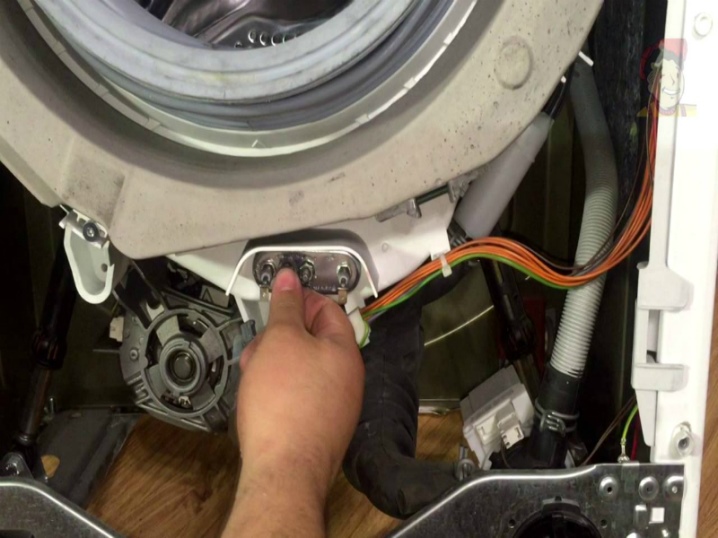
But scale as the cause of a malfunction is the most common. It settles on the body of the device, made of metal, and has a negative effect on the heating element, because of which it can simply break. Scale deposits are caused by the poor quality of the tap water and its high hardness. Moreover, even the installation of a special filter does not prevent the formation of scale.
Usually, at first, the device simply heats up poorly due to the fact that scale interferes with the transfer of the generated heat to water, and it overheats. In the end, at some point it is simply discovered that the heating element has broken down.
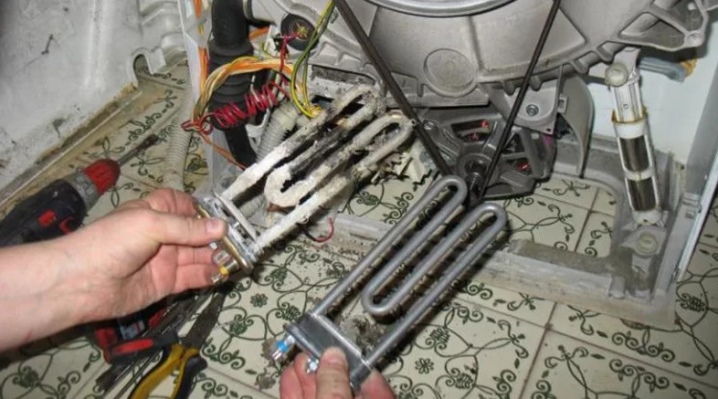
Here you need to add that scale forms conditions on the surface of the part for the formation of corrosion. Over time, this becomes the reason for the deformation of its metal case.And an element that has lost its tightness becomes very vulnerable to external factors and increases the risk of a short circuit.
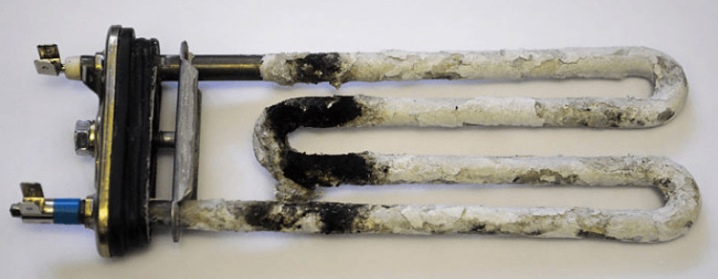
By the way, another reason can be called improper operation of the washing machine by the user. The point is that a malfunction of the heating element may result from the use of unsuitable detergents. We are talking either about exceeding the amount of powder, or using compositions for washing by hand. In this case, a very dense film of soapy concentrate can form. It becomes an obstacle for proper heat transfer, which creates the risk of overheating of the heating element and its breakdown.
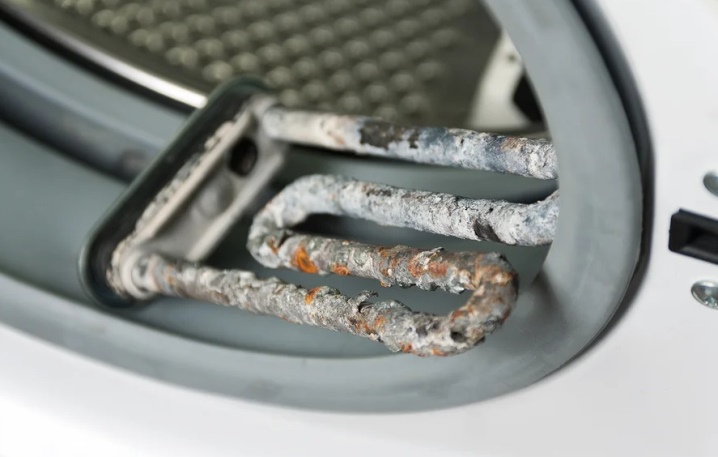
Diagnostics
It is not necessary to disassemble the washing machine and use a multimeter to recognize a malfunction. The following phenomena may indicate problems:
- the washing machine draws water, but very quickly finishes washing and turns off completely after 5-7 minutes;
- water during washing is not heated to the level set by the program;
- almost immediately after the machine turns on, it knocks out traffic jams in the room;
- the quality of washing is significantly reduced;
- the body shocks when touched;
- an unpleasant smell of burning is felt in the room while using the device.
These signs indicate that the device needs inspection and subsequent repair.

If you have a multimeter at hand, then it will not be superfluous to check the performance of the dielectric and the spiral. This can be done by checking the resistance of the element. according to the formula:
R = U² / P
The resistance of the heating element will be equal to the square of the voltage that goes to it, which should be divided by the power of the device itself. That is, for example, the voltage that goes to the heater is 220 volts, as in a regular outlet. And the power of the heating element is 2000 watts. This results in a value of just over 24 ohms, and this will be normal resistance. If the heating element is OK, the tester will show this value.
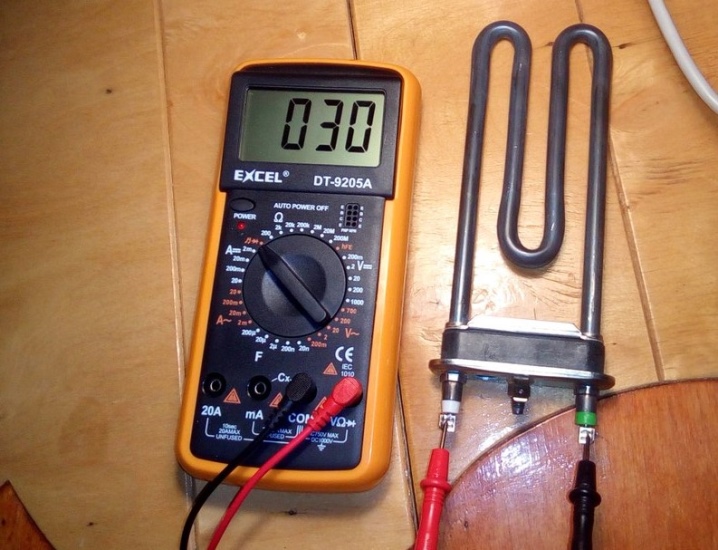
To measure resistance, you should perform the following actions:
- switch the tester to the resistance measurement mode by setting the switch to the 200 Ohm mark;
- touch the multimeter probes to the heater terminals;
- see the obtained value on the display of the device.
If you see numbers 1 or 0 on the screen of the device, then the relay in the heating element is faulty.
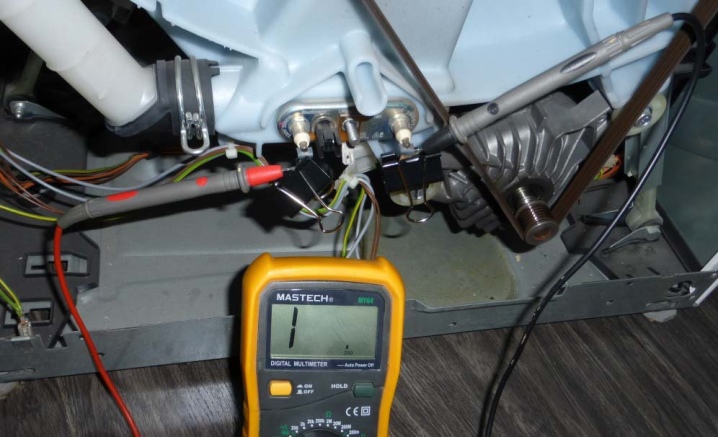
If it is required to check the dielectric of the heating element, then the following steps should be taken:
- switch the tester to the dialing mode by setting the switch to the "Buzzer" mode;
- touch the heating element terminal with one probe;
- Lean the second probe against the grounded terminal or the heating element body.
If the device starts emitting a squeak, then the dielectric passes current to the body of the device - this means that the heating element is broken. And if there is no sound, then the heating element is serviceable and the breakdown should be looked for elsewhere.
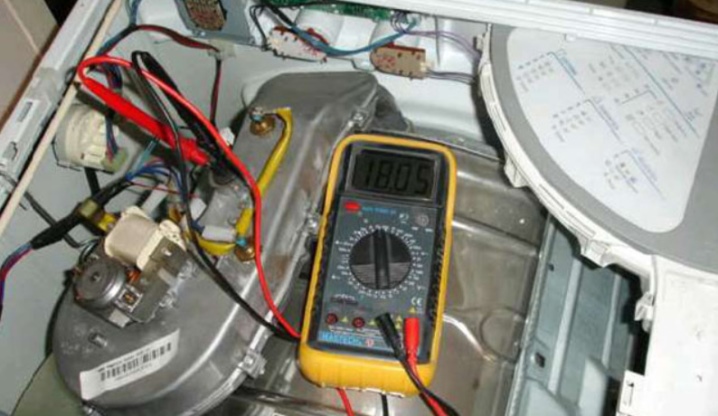
Repair
So, suppose that we need to repair the heating element, because it was found that it is faulty. Let's try to figure out how to do this. The only thing you need to know is that it is almost impossible to repair the heating element. As a rule, we are talking about replacing it with a new one. Let's assume that you already know where the heating element is located in the typewriter. Then you can start disassembling the case. To do this, disconnect the device from the network, and then disconnect the drain pipe and the hose through which water enters the machine during washing. It is also necessary to drain off the remaining water that remained in the washing machine after the last use.
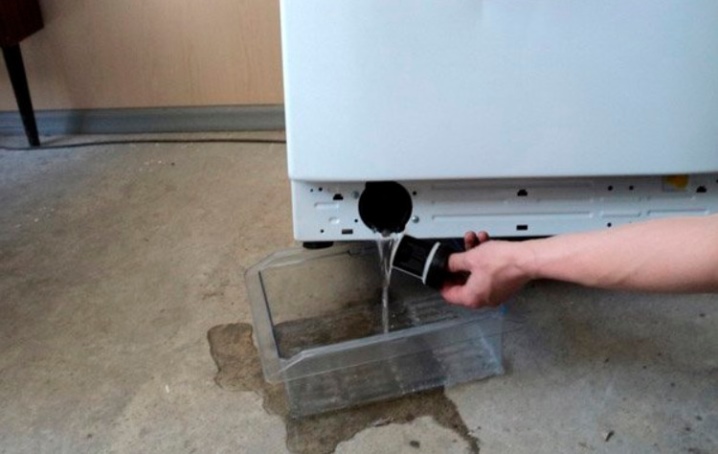
After that, we dismantle the back cover, and if the heating element is located behind it, then remove it and change it to another. If it is necessary to dismantle the front cover in your washing machine, then the following steps should be taken:
- dismantle the top cover;
- pull out the detergent drawer;
- remove the hoop made of steel from the seal on the hatch;
- unscrew the seal itself and the door lock;
- unscrew the front panel.
After that, access to the heating element will be open.
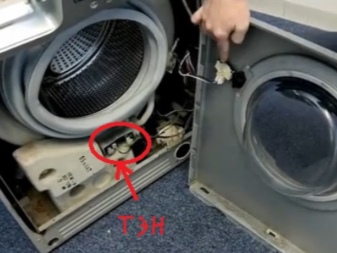
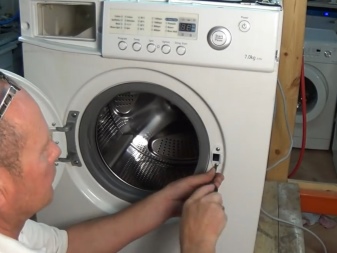
So, to replace the heating element, you will need to unscrew one nut, which holds it... Before doing this, disconnect the power terminals, ground and cables that come from the temperature sensor. It is best to unscrew the nut with a socket wrench. If it is not there, then you can do it with a horn instrument. We unscrew it almost to the end, after which we press the pin inward, which will make it possible to pull the heating element out of the seat. After that, unscrew the nut to the end and carefully loosen the element in order to carefully pull it out. Now it remains to insert a new heating element in place of the old one and assemble by performing all the above steps in reverse order.
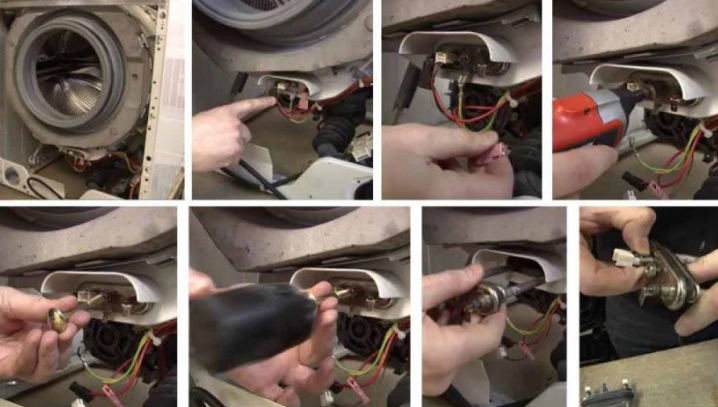
Recommendations
To begin with, it will not be superfluous to compare the broken element with the one with which you are going to replace it. The more criteria and characteristics by which they coincide, the better.
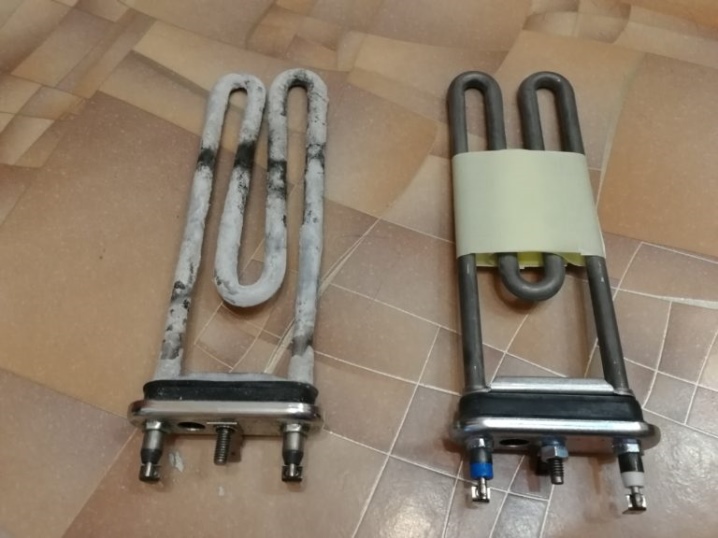
In addition, it will not be superfluous to arm yourself with a diagram of a specific washing machine before starting repairs. This will help you quickly figure out where the item you are interested in is located, and understand the easiest way to get to it.
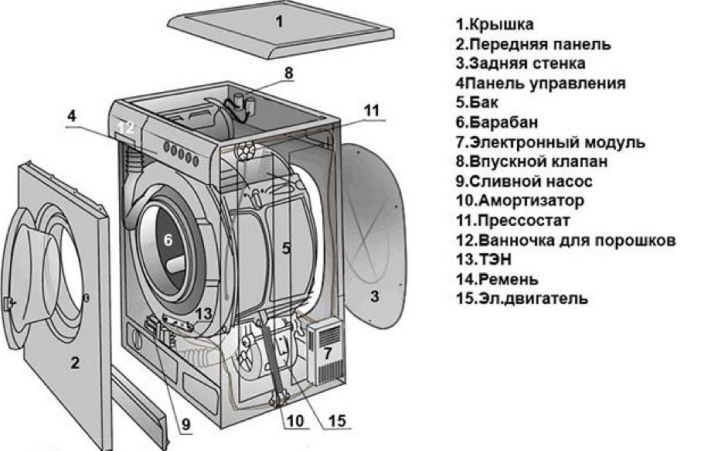
If you have no experience in disassembling and replacing such parts of the washing machine, then you can seek advice from the master from the nearest service center. This will give you the opportunity to fill the gaps in knowledge and make an independent replacement of the heating element at home without much effort.

Besides, be sure to have a tester handy when checking the heating element for faults... Without it, there is no way to check the performance of the dielectric and assess its serviceability, which can cause an incorrect assessment of the situation and the replacement of a working heating element.

As you can see, self-replacement of the heating element of the washing machine looks relatively easy.
At the same time, this process requires an understanding of your own actions, certain knowledge in the field of electronics and skills in using a multimeter, as well as some simple tools.
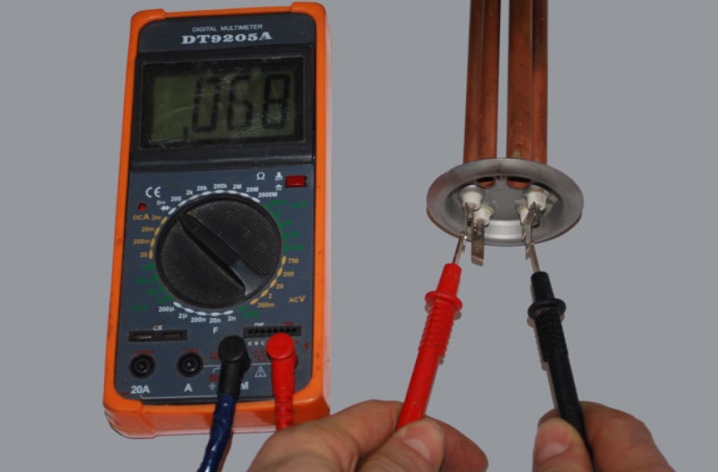
In the next video, you will learn how to change the heating element in the washing machine yourself.













The comment was sent successfully.